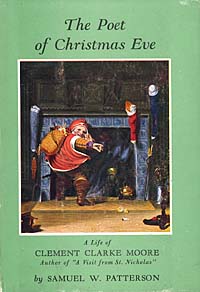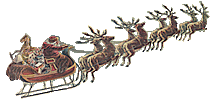|
From the Indianapolis News:
A century ago on December 23, 1823, was first published what has proved to be the most famous bit of Christmas literature
ever created by an American author - that jingle (printed elsewhere on this page) familiar to every child and remembered by every adult, beginning
'Twas the night before Christmas, when all through the house
Not a creature was stirring, not even a mouse.
The publisher of it, Orville Holley, editor of the Troy (N. Y.) Sentinel, did not know the author, it having been sent in anonymously,
but he printed it with this note of appreciation: "From whomsoever it may come, we give thanks for it. There is, to our
apprehension, a spirit of cordial goodness in it, a playfulness of fancy and a benevolent alacrity to enter into the feelings
and promotte the simple pleasures of children which are altogether charming."
|
[Livingston's poem 'Timmy']
Master Timmy brisk and airy
Blythe as Oberon the fairy
On thy head thy cousin wishes
Thousand and ten thousand blisses.
Never may thy wicket ball
In a well or puddle fall;
Or thy wild ambitious kite
O'er the Elm's thick foliage light.
When on bended knee thou sittest
And the mark in fancy hittest
May thy marble truly trace
Where thy wishes mark'd the place.
If at hide and seek you play,
All involved in the hay
Titt'ring hear the joyful sound
"Timmy never can be found."
If you hop or if you run
Or whatever is the fun,
Vic'try with her sounding pinion
Hover o'er her little minion.
But when hunger calls the boys
From their helter skelter joys:
Bread and cheese in order standing
For their most rapacious handling
Timmy may thy luncheon be
More than Ben's as five to three.
But if hasty pudding's dish
Meet thy vast capacious wish -
Or lob-lollys charming jelly
Court thy cormorantal belly
Mortal foe to megre fast
Be thy spoonful first & last.
|
[Moore's poem 'To a Young Lady
on her Birth-day']
To hail thy natal day, fair maid,
Once more I wake the lyre;
Once more invoke each favoring muse
My accents to inspire.
But frown not if my humble strain
No soothing homage pay
To all the charms that grace thy mind,
Or round thy features play.
Alas! the brightest charms but yield
A taper's trembling light;
When fann'd by praise, awhile they glare,
Then vanish from the sight;
Or, like the soft unsullied snows
That fall in graceful play,
They shrink beneath the gentlest touch,
And, silent, melt away.
Nor shall the Muse thy foibles mark
With keen relentless eye,
That seem like clouds of lightest wing
That speck the vernal sky.
O! may young life's empurpled morn,
Still mantling round thy head,
Its balmly airs of youthful hope,
with kindest influence, shed.
May every cloud of darker hue,
Ere evening shades advance,
Dissolve away, or just be seen
To skirt the blue expanse.
And may soft tints of rosy light,
With gold of purest ray,
Their mild effulgence widely throw
Around thy closing day.
|
Not only this, but Holley republished it in subsequent Christmas numbers, and used it with a pictorial border
as a carrier's greeting. It was widely quoted, and always unsigned, until 1837, when an anthology called
"The New York Book of Poetry" was published, and in it was "A Visit From St. Nicholas," attributed to Clement C. Moore. In 1844 appeared
the collected poems of Dr. Moore, of New York, and among them was the famous Christmas jingle.
It is still attributed to Dr. Moore, but a claim to its authorship was made by the family of Henry Livingstone, a reputable
amateur poet, who lived near Pioughkeepsie. Other verse written by Livingston shows the same mental characteristics.
The other poetry of Dr. Moore, on the other hand, is for the most part stately and formal.
Moore was, first of all, a grave and learned professor of oriental and Greek literature, an instructor in theology and
a lexicoxgrapher. Such circumstantial evidence might weight against him if the author of "Alice in Wonderland" had not proved that an
erudite professor might also be a dabbler in delightful nonsense.
Of the little classic Burton E. Stevenson says:
"It standardizes Santa Claus. It visualized the appearance of the old saint so clearly that no artist since has dared to depart from the specifications
there set down. Clarence Cook well called it 'a true piece of Dutch painting in verse.' No homely detail is overlooked, and each
is drawn with rare precision. St. Nicholas is painted for all time as a jolly, fun-loving, rotund old elf, whose ruddy skin and
bright eyes belie his snow-white beard: who dimples with merriment and makes one laugh just to look at him.
[Livingston's poem 'Apollo Rebus']
The initials of these if you place with precision
Will show you a damsel whose smile is Elysian.
Blended high in her cheek is the rose's rich dye,
With the crimson of rubys her lovely lips vie.
Her breath aromatic surpasses the gales
When fraught with the sweets of ten thousand sweet vales.
Her brow the lake's smoothness exhibits serene,
Its calm representing the sunshine within.
Clad in furs, his sack of toys slung across
his back, he skims over the housetops in his little
sleigh, whistling and shouting to his reindeer.
That sleigh drawn by reindeer was pure inspiration!
[With a dash of Washington Irving's Knickerbocker's History of New York]
[Livingston's poem 'War Rebus']
Take the name of that hero who dreadful in war
Spread the terror of Rome thro the nations afar,
With the King of the fairies that sly jealous sprite
Who sleeps all the day but who gambols all night
Green caty-dids draw him - a nutshell contains him,
His kingdom a meadow & a dewdrop sustains him.
|



![]() Copyright © 2014, InterMedia Enterprises
Copyright © 2014, InterMedia Enterprises